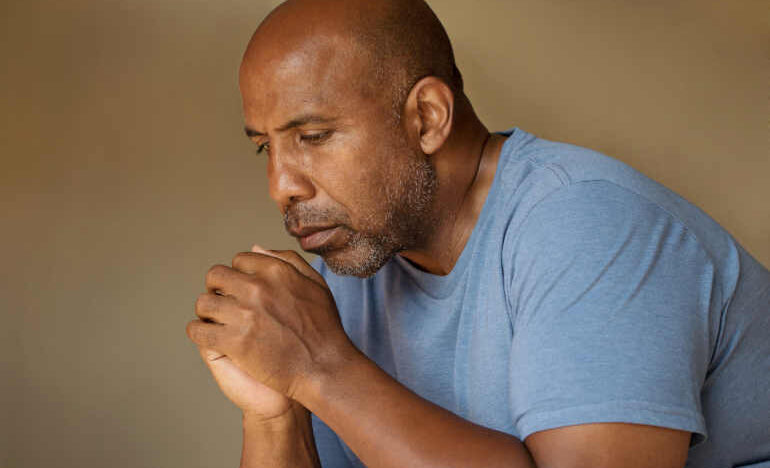Pray without Ceasing — Really? Part 1

By Kathy Keary
Part 2 of 3. Read all the articles here.
I find it intriguing that some memories stay with us forever like a precious treasure that we secure in a lockbox while other happenings in our lives are like leaves dancing about on a windy autumn day never to be seen again.
I can remember like it was yesterday receiving a special message as I was driving many years ago on a very familiar street not far from my home. I distinctly heard with the ear of my heart God suggesting that I become more like my dad who was no longer on this side of eternal life.
Of course, the Divine did not lay out a detailed plan on how to achieve that leaving it to me to figure it out. In reflecting on my dad’s life, the fact that he maintained a close relationship with Jesus was clear as evidenced by Thomas Kempis’ The Imitation of Christ he kept handy on his nightstand.
Never miss an article published to the Renewal Center website: Sign up to receive our newsletters.
An in-depth study of Jesus followed in an attempt to uncover more about this figure that had captivated my father’s heart. I devoured many books about Jesus including an immersion into Scripture. Among the characteristics that struck me was Jesus fidelity to prayer.
As emphasized in Ronald Rolheiser’s book, Sacred Fire: A Vision for a Deeper Human and Christian Maturity, Jesus prayed in every kind of situation. He prayed during times of joy as well as times of agony. He prayed in the company of others as well as retreating to a secluded place to commune with the Sacred One. He prayed high on a mountain and on level ground where daily life carries on. He prayed in broad daylight as well as through the night. It was clear to his disciples that his strength, courage, and compassion was directly linked to the intimacy he enjoyed with the Holy One.
St. Paul in his First Letter to the Thessalonians challenges us to “pray without ceasing” (5:16). In his Letter to the Ephesians, he advises: “With all prayer and supplication, pray at every opportunity in the Spirit” (6:18). This is a recurring theme throughout Scripture. In the Psalms, we find these words: “You are my God, pity me, Lord; to you I call all the day” (86:3). Jesus instructs in the Gospel of Luke: “Pray always without becoming weary” (18:1).
Certainly, that does not mean that we are to be on our knees with hands folded and head bowed 24/7. So what does it mean? How can we live our lives fulfilling our responsibilities, and at the same time, pray without ceasing? Is this just a lofty goal not to be taken literally? While it may be very difficult to achieve this during our earthly journey, there are steps we can take to move closer to the realization of this goal.
Henri Nouwen in the book, Spiritual Direction: Wisdom for the Long Walk of Faith, describes unceasing prayer as thinking, speaking, and living in the presence of God. He explains:
Although it is important and even indispensable for the spiritual life to set apart time for God and God alone, prayer can only become unceasing prayer when all our thoughts — beautiful or ugly, high or low, proud or shameful, sorrowful or joyful — can be thought and expressed in the presence of God. Thus, converting our unceasing thinking into unceasing prayer moves us from a self-centered monologue to a God-centered dialogue. This requires that we turn all our thoughts into conversation. The main question, therefore, is not so much what we think, but to whom we present our thoughts.
As one progresses in spiritual maturity, the type of ongoing conversation that Nouwen speaks of becomes a daily reality. You might think, “Doesn’t God know everything? Why would I bore him with the details of my life?” Just like with a loved one, sharing our life with God strengthens the bond we enjoy with our Maker and allows us to grow in intimacy with the divine. All topics and emotions remain on the table: joys, sorrows, fears, trials, challenges, temptations, sins, shames, regrets, worries, and blessings. Along the way, God becomes a trusted confidant, a best friend, a constant companion, a spouse.
Over the next couple of weeks, we will explore multiple ways that foster keeping God at the center of our day and our life in order to move closer to the ideal of praying without ceasing. Perhaps some will speak to your heart. Stay tuned.
Note: New articles in this series are posted to the website every Monday. The full series can be found here: An Invitation to Something New: The Contemplative Life. On Thursday’s we’ll send an email to remind you of the articles.
[Kathy Keary, a Precious Blood Companion and spiritual director, holds a master’s degree in theological studies and is a graduate of the Atchison Benedictine’s Sophia Center’s Souljourners Program, an intense study of spirituality and spiritual direction. Kathy believes that the divine is present and active in all of life and encourages others to be awakened to the God in all including the divine within. She enjoys accompanying others on their journey to wholeness discovering the person they were created to be.]
Photo 59604433 © Gary Cooper | Dreamstime.com
We’d Like to Hear From You!
We’d like to know what you think about our The Contemplative Life Series. Send us a comment using the form below. Do you have a suggestion? Is there something you want to learn more about? Send us a note.
Related

What’s the Problem?
By Fr. Garry Richmeier, C.PP.S.
You can’t fix a relationship or a behavior like a mechanic fixes a car or a surgeon “fixes” a patient. Behaviors and relationships don’t have parts that can be fixed or replaced when the break or malfunction.

Lent Video Five – Meditation: “Only a Shadow of You Love”
Next Sunday is Palm Sunday and next week is Holy Week. In anticipation of those solemn commemorations, today, Fr. Ron will help us pray and meditate on the Stations of the Cross.
Categories
Assembling God's Puzzle Coffee with Padre Cooking & Spirituality Encounters of the 4th Kind Family Matters Reflections on the Eucharsitic Prayers Spiritual Resources Taize Prayers The Contemplative Life Traveling with Pilgrims of Hope Uncategorized Videos Week of Prayer for Uhristian Unity When you need a little help
